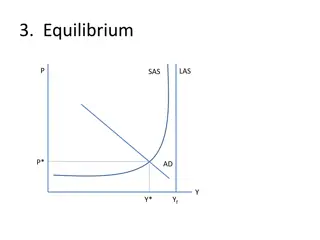Understanding Aggregate Supply and Demand in Economics
Explore the concept of aggregate supply and demand, including determinants and the relationship between price level and quantity demanded. Learn about the reasons for the downward slope of the aggregate demand curve and why the law of demand doesn't directly apply to the economy as a whole. Discover how shifts in the aggregate demand curve occur and the determinants influencing these shifts, along with insights on the short-run aggregate supply curve.
Download Presentation

Please find below an Image/Link to download the presentation.
The content on the website is provided AS IS for your information and personal use only. It may not be sold, licensed, or shared on other websites without obtaining consent from the author. Download presentation by click this link. If you encounter any issues during the download, it is possible that the publisher has removed the file from their server.
E N D
Presentation Transcript
Aggregate Supply & Demand Introduction & Determinants
Aggregate Demand Curve (Inverse) Relationship between price level & quantity of aggregate output demanded for the economy as a whole Aggregate Price Level (measured with GDP deflator) Total quantity of domestic goods & services demanded (= real GDP)
Reasons for Downward Slope A. Interest Rate Effect To get what they want during periods of rising prices, households and firms borrow money or sell assets. This drives up interest rates, reducing investment and consumer spending. Wealth Effect A rise in aggregate price level results in a fall in purchasing power and a reduction in consumption. Net Export Effect As price levels rise, foreign goods become relatively cheaper and demand for imports rises (while demand for exports falls). B. C.
Why the Law of Demand DOESNT apply The Law of Demand assumes ceteris paribus, including the assumption that all other goods remain equal and it is therefore not applicable to the economy as a whole. Movement up and down the AD curve represents simultaneous change in prices of all final goods and services. This is why the interest rate, wealth, and net export effects provide a better explanation.
Shifts of AD Curve Changes in AD as a result of price level changes are movements along the curve Shifts occur when the quantity demanded at a given price level changes increase to the right, decrease to the left.
Determinants of AD Shifts occur because of: 1. Changes in Expectations future income 2. Changes in Wealth value of assets 3. Size of Existing Stock incentive for firms 4. Fiscal Policy control of demand through government spending and tax policies 5. Monetary Policy use of quantity of money and interest rates to stabilize the economy
Short-Run Aggregate Supply Curve Shape of the Curve Two situations result in SRAS curves with no slope: 1. Horizontal SRAS curve results from set price level or high unemployment (making wages flexible) 2. Vertical SRAS curve represents full employment and utilization of resources so prices can rise, but production cannot.
Short-Run Aggregate Supply Curve In reality, the curve is normally an upward sloping line as a result of production decisions being based on profitability and the inflexibility of costs in the short-run. In a perfectly competitive market, when price levels change but costs don t, the change in profit margin determines quantity produced In an imperfectly competitive market, producers raise prices and production at times of high demand and cut prices and production when demand falls
Shifts of SRAS Curve Changes in aggregate output in response to price level is movement along the curve Shifts represent changes in the quantity of aggregate output producers are willing to supply at a given aggregate price level increase to the right, decrease to the left.
Determinants of SRAS Shifts occur because changes impact per unit cost, like: 1. Changes in Commodity Prices 2. Changes in Nominal Wages Economy-wide 3. Changes in Productivity
SRAS Scenarios Price Level Real GDP Price Level Real GDP Price Level Real GDP
Long-Run Aggregate Supply Curve In the long-run, all production costs are flexible. Therefore, in the long run, aggregate price level has no effect on quantity supplied. YP
Potential Output The horizontal intercept represents an economy s potential output the level of production if all prices were fully flexible. Actual output fluctuates around YP from year to year.
Shifts in LRAS Curve Growth in potential output over time is the result of rightward shifts of the LRAS curve as a result of: 1. Increases in quantity of resources 2. Increases in quality of resources 3. Improvements in technology
SRAS to LRAS Economy is always at a point (PL & real GDP) on the SRAS curve. If that point is not also on the LRAS curve, the SRAS curve will shift until it is. Let s look at two scenarios























